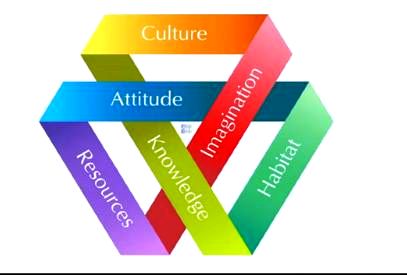From Tina Seelig’s book inGenius: A Crash Course on Creativity:
Below is the fully functional Innovation Engine, showing how all the parts are braided together. The inside of the engine is intertwined with the outside; and the factors on the inside and outside mirror each other. All the parts of your Innovation Engine are inexorably connected and deeply influence one another.
- Your attitude sparks your curiosity to acquire related knowledge.
- Your knowledge fuels your imagination, allowing you to generate innovative ideas.
- Your imagination catalyzes the creation of stimulating habitats, leveraging the resources in your environment.
- These habitats, along with your attitude, influence the culture in your community.
Essentially, creativity is an endless resource, initiated by your drive to tackle challenges and to seize opportunities. Anything and everything can spark your Innovation Engine —every word, every object, every decision, and every action. Creativity can be enhanced by honing your ability to observe and learn, by connecting and combining ideas, by reframing problems, and by moving beyond the first right answers. You can boost your creative output by building habitats that foster problem solving, crafting environments that support the generation of new ideas, building teams that are optimized for innovation, and contributing to a culture that encourages experimentation.
You hold the keys to your Innovation Engine and have creative genius waiting to be unleashed. By tapping into this natural resource, you have the power to overcome challenges and generate opportunities of all dimensions. Your ideas—big and small—are the critical starting point for innovations that propel us forward. Without creativity, you are trapped in a world that is not stagnant, but one that slips backwards. As such, we are each responsible for inventing the future. Turn the key.
At the halfway point in the Lean Service Design Trilogy course, we review the path we have taken. It looks like this:
- We understand what we do well.
- We know the service products that we have.
- We understand Standard Work.
- We know what is important to our customers.
- We understand the customer experience.
- We know how to improve our service product based on what is important to our customer.
- We know our own culture.
We have gone through the process of SDCA and PDCA to prepare us for the section on EDCA or Design. Why the preparation? Design and Innovation takes place outside the four walls and Lean is the methodology and culture of choice. It drives both the Little i and the Big I. The first and foremost reason is that it allows for the 1st step of innovation, the little i. Lean is the primary driver for the little i – PDCA. As a result, it allows for that culture to spread and create the DNA for the BIG I. Without Lean and the little i, you may never start!
The little “i” provided through SDCA and PDCA defined as the Lean Culture will stimulate the knowledge, imagination, and attitude to create something from nothing. You have the skills needed. Creativity, Design and Imagination are all learned practices. Your own Lean Innovation Engine consists of:
- SDCA: Standard Work that creates a CAN-DO attitude and frees up time to spark problem solving.
- Applying PDCA, allows you to “see” opportunities for improvement.
- A Continuous Improvement Culture (Kaizen) catalyzes the creation of stimulating habitats, leveraging the resources in your environment.
- These habitats, along with your attitude, influence the culture in your community (The Customer Experience will mimic the Employee Experience).
This is an 18 minute video with Tina Seelig’s discussing the Innovation Engine highlighted in her book inGenius: A Crash Course on Creativity. Review it from a perspective of using the Lean Innovation Engine. Your thoughts?


Comments are closed.